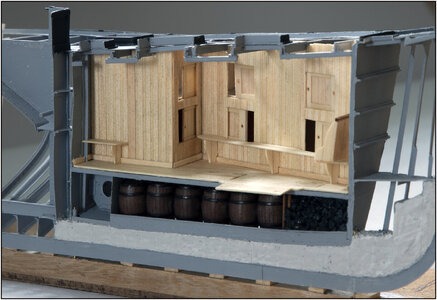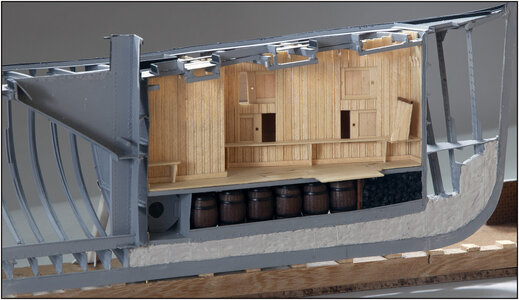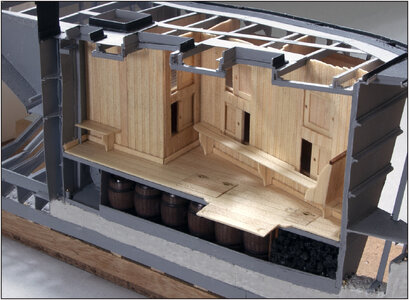Those sailors were packed in. Could the average sailor stand up in the bunk area common?
-

Win a Free Custom Engraved Brass Coin!!!
As a way to introduce our brass coins to the community, we will raffle off a free coin during the month of August. Follow link ABOVE for instructions for entering.
You are using an out of date browser. It may not display this or other websites correctly.
You should upgrade or use an alternative browser.
You should upgrade or use an alternative browser.
BALDER, Vlaardingen Herring Lugger from 1912, scratch build scale 1:50 Plate-On-Frame
- Thread starter Peter Voogt
- Start date
- Watchers 64
Thanks, Peter. I am happy that I was able to contribute to that.My next jar of pickled herring will hold special meaning!
Regards, Peter
It's more that they use the limited space very effectively. Each bunk is +2 meter long and men where a bit shorter those days.Those sailors were packed in.
Well, Daniel. You have to turn out the bunk to stand up. There will also be a bench along the wall where they could stand on to climb into the upper bunks.Could the average sailor stand up in the bunk area common?
Later on there will be some reference for the height of the forecastle. But you can stand there.
When I visit the Balder again I will take a picture from myself standing there.
Regards, Peter
If your pickled herring is as old as this ship, and you eat it it will get a real special meaning.My next jar of pickled herring will hold special meaning!

Just fantastically detailed again at this small scale Peter.
Guess your structure becomes very ridged by now.
Guess your structure becomes very ridged by now.
Thanks, Maarten. After every step, the floor, the inside hull planks and now the inside walls, there was less flex in the construction. Which is now almost impossible to deform. Even with this dry fit installation.Just fantastically detailed again at this small scale Peter.
Guess your structure becomes very ridged by now.
When I do the gluing of the parts I’ll check the structure constantly by turning the template after every step to prevent a deformation length wise.
Regards, Peter
I love your detailed work on this model - everytime new amazing details - inspirational
Thanks , Uwe. One of the reasons for me by showing some inbetween step is to inspire others. It’s perhaps with scratch building often not what you made it but more how you made it.I love your detailed work on this model - everytime new amazing details - inspirational
Regards, Peter
Last edited:
Such a wonderful build log, with the unique mix of materials and the precise description, with pictures, of each step in your construction process!!
Everyone can learn something from this superb modeling and narrative. The fact that you have (and will again) visit the actual ship really adds authenticity!
Thanks so much for sharing your wonderful talents on this unique build!!!
Everyone can learn something from this superb modeling and narrative. The fact that you have (and will again) visit the actual ship really adds authenticity!
Thanks so much for sharing your wonderful talents on this unique build!!!
What a nice words and compliments, Brad. You made my quiet for a moment. I am glad that the build-log is inspirational for other builders.Such a wonderful build log, with the unique mix of materials and the precise description, with pictures, of each step in your construction process!!
Everyone can learn something from this superb modeling and narrative. The fact that you have (and will again) visit the actual ship really adds authenticity!
Thanks so much for sharing your wonderful talents on this unique build!!!
Regards, Peter
It took me about half an hour to install the parts:

Everything actually was fitting perfectly.
The book of the 1st restoration states:
"Contrary to what was stated in the specifications of November 1911, the paneling of the forecastle was not painted, nor was the floor. Gilles Penning had preferred unpainted wood, because it was easier to clean with water and soda."
-A skirting board has been installed to ensure that water does not penetrate into the lower ends of the bead parts.
-In the rear/left corner is the bench that provides a view of the stove in the galley.
-A bench along the long and end wall. The 'stop boxes' will be placed under the sofa. Each crew member had such a chest with personal belongings.

- 'De Stee' is placed against the front wall. Here with the left seat with partition. The other would have been in the starboard section. With an open space behind it. The smallest details so far are 3 brackets on the wall on which the crew can hang wet clothing. It then hangs partly in the free space behind the backrest of 'de Stee'.
Everything is put in linseed oil.
It may seem that the bench partly closes off the 2 lower entrances:

But a recess has been made around both openings so that one can easily climb in and out of those bunks.
They also used the bench to climb into the 2 top bunks.
Regards, Peter

Everything actually was fitting perfectly.
The book of the 1st restoration states:
"Contrary to what was stated in the specifications of November 1911, the paneling of the forecastle was not painted, nor was the floor. Gilles Penning had preferred unpainted wood, because it was easier to clean with water and soda."
-A skirting board has been installed to ensure that water does not penetrate into the lower ends of the bead parts.
-In the rear/left corner is the bench that provides a view of the stove in the galley.
-A bench along the long and end wall. The 'stop boxes' will be placed under the sofa. Each crew member had such a chest with personal belongings.

- 'De Stee' is placed against the front wall. Here with the left seat with partition. The other would have been in the starboard section. With an open space behind it. The smallest details so far are 3 brackets on the wall on which the crew can hang wet clothing. It then hangs partly in the free space behind the backrest of 'de Stee'.
Everything is put in linseed oil.
It may seem that the bench partly closes off the 2 lower entrances:

But a recess has been made around both openings so that one can easily climb in and out of those bunks.
They also used the bench to climb into the 2 top bunks.
Regards, Peter
Last edited:
This is all just so wonderful Peter. I truly love the contrast of the wood with the steel. Per usual, your skills were up to the challenge!
I wish we had more reaction images, the 'love' reaction is insufficient. Admins, please add additional reactions specifically 'Wonderfully Amazing'! Those wooden parts are in harmony with the grey-painted steel! Just Wonderfully Amazing, Peter!!
Just wonderfull Peter.It took me about half an hour to install the parts:
View attachment 457471
Everything actually was fitting perfectly.
The book of the 1st restoration states:
"Contrary to what was stated in the specifications of November 1911, the paneling of the forecastle was not painted, nor was the floor. Gilles Penning had preferred unpainted wood, because it was easier to clean with water and soda."
-A skirting board has been installed to ensure that water does not penetrate into the lower ends of the bead parts.
-In the rear/left corner is the bench that provides a view of the stove in the galley.
-A bench along the long and end wall. The 'stop boxes' will be placed under the sofa. Each crew member had such a chest with personal belongings.
View attachment 457472
- 'De Stee' is placed against the front wall. Here with the left seat with partition. The other would have been in the starboard section. With an open space behind it. The smallest details so far are 3 brackets on the wall on which the crew can hang wet clothing. It then hangs partly in the free space behind the backrest of 'de Stee'.
Everything is put in linseed oil.
It may seem that the bench partly closes off the 2 lower entrances:
View attachment 457473
But a recess has been made around both openings so that one can easily climb in and out of those bunks.
They also used the bench to climb into the 2 top bunks.
Regards, Peter
For the full genuine experience you could have used fish oil instead of linseed
Thanks, Paul. I also do like the contrasting colors.This is all just so wonderful Peter. I truly love the contrast of the wood with the steel. Per usual, your skills were up to the challenge!
Thanks, Stephan. The ‘kraaldelen’ gives her a old fashion appearance.Looks are almost real in scale. Hard to see that it is a model. The 'kraaldelen' are very authentic.
Thanks, Jim. We will see if the admins can find some representatives reaction images.I wish we had more reaction images, the 'love' reaction is insufficient. Admins, please add additional reactions specifically 'Wonderfully Amazing'! Those wooden parts are in harmony with the grey-painted steel! Just Wonderfully Amazing, Peter!!
Thanks, Maarten. You don't want to know what that smells like. My mother told me that her father often had to take off his work clothes outside and then immediately put them in the wash. Himself too, by the way.Just wonderfull Peter.
For the full genuine experience you could have used fish oil instead of linseed
Regards, Peter
Thanks, Maarten. You don't want to know what that smells like. My mother told me that her father often had to take off his work clothes outside and then immediately put them in the wash. Himself too, by the way.
Regards, Peter
Haha, I know, have been a lot on the bif fishing trawlers in the past. These still smell the same

- Joined
- Sep 3, 2021
- Messages
- 5,148
- Points
- 738

I think the outfitting of the focsle clearly displays the advantages of the slightly larger scale of your Balder, when compared with the 1:72 Blueose. At least to me the detailing looks more "organic" or natural (by no means meant to be derogatory to your Bluenose model).It took me about half an hour to install the parts:
View attachment 457471
Everything actually was fitting perfectly.
The book of the 1st restoration states:
"Contrary to what was stated in the specifications of November 1911, the paneling of the forecastle was not painted, nor was the floor. Gilles Penning had preferred unpainted wood, because it was easier to clean with water and soda."
-A skirting board has been installed to ensure that water does not penetrate into the lower ends of the bead parts.
-In the rear/left corner is the bench that provides a view of the stove in the galley.
-A bench along the long and end wall. The 'stop boxes' will be placed under the sofa. Each crew member had such a chest with personal belongings.
View attachment 457472
- 'De Stee' is placed against the front wall. Here with the left seat with partition. The other would have been in the starboard section. With an open space behind it. The smallest details so far are 3 brackets on the wall on which the crew can hang wet clothing. It then hangs partly in the free space behind the backrest of 'de Stee'.
Everything is put in linseed oil.
It may seem that the bench partly closes off the 2 lower entrances:
View attachment 457473
But a recess has been made around both openings so that one can easily climb in and out of those bunks.
They also used the bench to climb into the 2 top bunks.
Regards, Peter
I don't want to think about how it was to live and work on these ships under the most dire circumstances possible.
As a youngster I sometimes slept in a bedstee (cupboardbed (?)), on my grandparents farm. It was, even as a child, difficult to get in and to get out and it was horribly cramped. I was to keep the doors of the bedstee open at all times, since ventilation was at best poor.
Now think about grown-up men having to get in, sleep and get out of these bedstees under all possible weather conditions. This part of your build clearly illustrates the minimalistic outfitting of these ships and as such forms a tribute to the fishermen of these days.
Thanks, Johan. Also for your 'contemplation'. Then also remember the old-fashioned thick rainwear that is wet from the salt water and processing the fish. I think you can then lean against the smell.I think the outfitting of the focsle clearly displays the advantages of the slightly larger scale of your Balder, when compared with the 1:72 Blueose. At least to me the detailing looks more "organic" or natural (by no means meant to be derogatory to your Bluenose model).
I don't want to think about how it was to live and work on these ships under the most dire circumstances possible.
As a youngster I sometimes slept in a bedstee (cupboardbed (?)), on my grandparents farm. It was, even as a child, difficult to get in and to get out and it was horribly cramped. I was to keep the doors of the bedstee open at all times, since ventilation was at best poor.
Now think about grown-up men having to get in, sleep and get out of these bedstees under all possible weather conditions. This part of your build clearly illustrates the minimalistic outfitting of these ships and as such forms a tribute to the fishermen of these days.
Regards, Peter
- Joined
- Sep 3, 2021
- Messages
- 5,148
- Points
- 738

I don't even want to think about it...Thanks, Johan. Also for your 'contemplation'. Then also remember the old-fashioned thick rainwear that is wet from the salt water and processing the fish. I think you can then lean against the smell.Maybe also fried bacon on the stove..........
Regards, Peter




